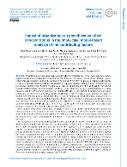Impact of urbanization on gas-phase pollutant concentrations: a regional-scale, model-based analysis of the contributing factors

Author
Bartík, Lukáš
Publication date
2022Published in
Atmospheric Chemistry and PhysicsVolume / Issue
22 (18)ISBN / ISSN
ISSN: 1680-7316ISBN / ISSN
eISSN: 1680-7324Metadata
Show full item recordCollections
This publication has a published version with DOI 10.5194/acp-22-12647-2022
Abstract
Urbanization or rural-urban transformation (RUT) represents one of the most important anthropogenic modifications of land use. To account for the impact of such process on air quality, multiple aspects of how this transformation impacts the air have to be accounted for. Here we present a regional-scale numerical model (regional climate models RegCM and WRF coupled to chemistry transport model CAMx) study for present-day conditions (2015-2016) focusing on a range of central European cities and quantify the individual and combined impact of four potential contributors. Apart from the two most studied impacts, i.e., urban emissions and the urban canopy meteorological forcing (UCMF, i.e., the impact of modified meteorological conditions), we also focus on two less studied contributors to the RUT impact on air quality: the impact of modified dry deposition due to transformed land use and the impact of modified biogenic emissions due to urbanization-induced vegetation modifications and changes in meteorological conditions affecting these emissions. To quantify each of these RUT contributors, we performed a cascade of simulations with CAMx driven with both RegCM and WRF wherein each effect was added one by one while we focused on gas-phase key pollutants: nitrogen, sulfur dioxide (NO2 and SO2), and ozone (O-3). The validation of the results using surface observations showed an acceptable match between the modeled and observed annual cycles of monthly pollutant concentrations for NO2 and O-3, while some discrepancies in the shape of the annual cycle were identified for some of the cities for SO2, pointing to incorrect representation of the annual emission cycle in the emissions model used. The diurnal cycle of ozone was reasonably captured by the model. We showed with an ensemble of 19 central European cities that the strongest contributors to the impact of RUT on urban air quality are the urban emissions themselves, resulting in increased concentrations for nitrogen (by 5-7 ppbv on average) and sulfur dioxide (by about 0.5-1 ppbv) as well as decreases for ozone (by about 2 ppbv). The other strongest contributor is the urban canopy meteorological forcing, resulting in decreases in primary pollutants (by about 2 ppbv for NO2 and 0.2 ppbv for SO2) and increases in ozone (by about 2 ppbv). Our results showed that they have to be accounted for simultaneously as the impact of urban emissions without considering UCMF can lead to overestimation of the emission impact. Additionally, we quantified two weaker contributors: the effect of modified land use on dry deposition and the effect of modified biogenic emissions. Due to modified dry deposition, summer (winter) NO2 increases (decreases) by 0.05 (0.02) ppbv, while there is almost no average effect for SO2 in summer and a 0.04 ppbv decrease in winter is modeled. The impact on ozone is much stronger and reaches a 1.5 ppbv increase on average. Due to modified biogenic emissions, a negligible effect on SO2 and winter NO2 is modeled, while for summer NO2, an increase by about 0.01 ppbv is calculated. For ozone, we found a much larger decreases of 0.5-1 ppbv. In summary, when analyzing the overall impact of urbanization on air pollution for ozone, the four contributors have the same order of magnitude and none of them should be neglected. For NO2 and SO2, the contributions of land-use-induced modifications of dry deposition and modified biogenic emissions have a smaller effect by at least 1 order of magnitude, and the error will thus be small if they are neglected.
Keywords
urban land-surface, urbanization, air-quality simulations, ozone, nitrogen dioxide, sulphur dioxide, biogenic emissions, dry deposition
Permanent link
https://hdl.handle.net/20.500.14178/2087License
Full text of this result is licensed under: Creative Commons Uveďte původ 4.0 International






